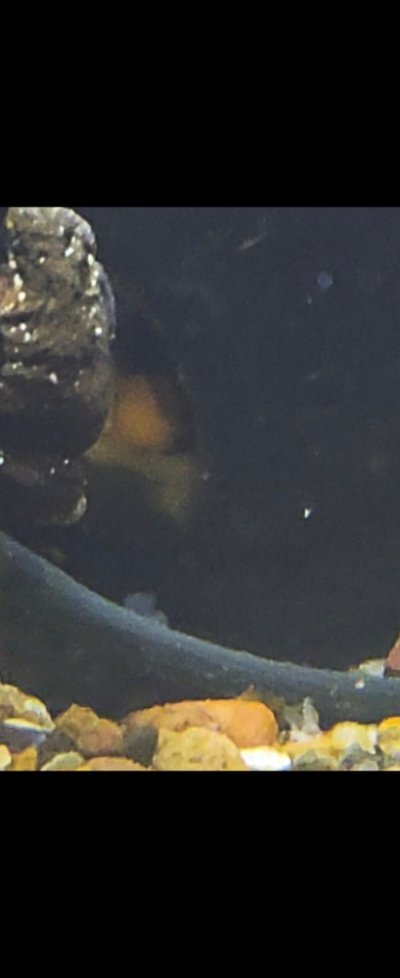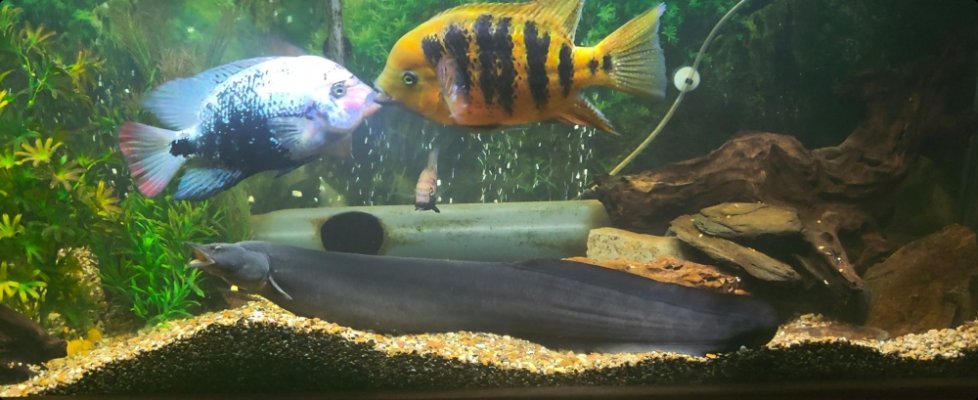Nothgiel
Aquarium Advice Newbie
- Joined
- Oct 18, 2022
- Messages
- 1
Hi all,
I've a large Tyre Track Eel.
I've attached a picture as best as I can of the issue, it shows his eyes, some if his nose but inside his mouth.
Inside, between the gills around an inch inward from the start of the bottom part of his mouth, there is a large Orange or Kind of Yellow growth which is pictured.
I've investigated myself to determine if it was either food that has unfortunately had a shell on part attached to the food given once without knowing and maybe it'd stuck in his mouth or maybe some kind if stone due to the colour.. could be either food or stone at that juncture but upon close inspection, delicate, it must be a growth is my only determination.
I noticed he was a bit off with temperament, he's a sociable eel normally is our Neel so we know he's not well, then he's only eating 20% of what he would daily, which continued for 4 or 5 days of feeding which is odd.. he is normally happy to pig out as much as his belly can fill until he's satisfied, he eats very very well normally and normally trusts me implicitly, which eel owners or those who know maybe also that your Eel must trust you to feed well. Its not easy getting food to him but he's very happy normally.
So upon the differences in behaviours, hence why I looked into his mouth just to see if something was preventing him raring or causing obstruction.. well whats pictured is a growth as said, he now hasn't eaten in 5 days when normally its good daily feeds.
I worry after the unsettling time he's had with the affliction itself and the investigation wasn't nice for anyone ?. At first after his shock died down, he was replacing his coat of slime it would seem, as he did develop new slime patches that I figured would turn back colour when kind of cured with time..like a new exoskeleton for others his slime would replace as a new coat. Anyway he wasn't happy for a couple of days but is back to his I'd self so Great News.. however the growth remains and he isn't eating still..
Any ideas what the growth is, the name or all and any information would be appreciated. Is it curable or treatable .?
Thank you.
Pictured are one of the issue this week and another was around 2 months ago.
I've a large Tyre Track Eel.
I've attached a picture as best as I can of the issue, it shows his eyes, some if his nose but inside his mouth.
Inside, between the gills around an inch inward from the start of the bottom part of his mouth, there is a large Orange or Kind of Yellow growth which is pictured.
I've investigated myself to determine if it was either food that has unfortunately had a shell on part attached to the food given once without knowing and maybe it'd stuck in his mouth or maybe some kind if stone due to the colour.. could be either food or stone at that juncture but upon close inspection, delicate, it must be a growth is my only determination.
I noticed he was a bit off with temperament, he's a sociable eel normally is our Neel so we know he's not well, then he's only eating 20% of what he would daily, which continued for 4 or 5 days of feeding which is odd.. he is normally happy to pig out as much as his belly can fill until he's satisfied, he eats very very well normally and normally trusts me implicitly, which eel owners or those who know maybe also that your Eel must trust you to feed well. Its not easy getting food to him but he's very happy normally.
So upon the differences in behaviours, hence why I looked into his mouth just to see if something was preventing him raring or causing obstruction.. well whats pictured is a growth as said, he now hasn't eaten in 5 days when normally its good daily feeds.
I worry after the unsettling time he's had with the affliction itself and the investigation wasn't nice for anyone ?. At first after his shock died down, he was replacing his coat of slime it would seem, as he did develop new slime patches that I figured would turn back colour when kind of cured with time..like a new exoskeleton for others his slime would replace as a new coat. Anyway he wasn't happy for a couple of days but is back to his I'd self so Great News.. however the growth remains and he isn't eating still..
Any ideas what the growth is, the name or all and any information would be appreciated. Is it curable or treatable .?
Thank you.
Pictured are one of the issue this week and another was around 2 months ago.


